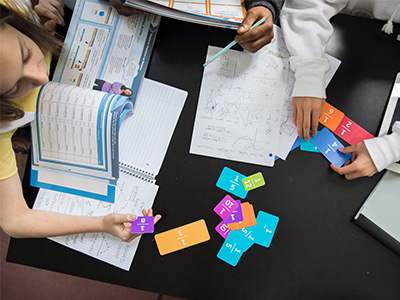Understanding Dyscalculia to Better Support Students
Watch the RecordingListen to the Podcast
While similar numbers of students have dyscalculia in relation to dyslexia, the amount of research done for dyslexia far outreaches the other. In fact, it wasn’t until 1985 that researchers developed a cognitive model for numerical and calculation processing, and it wasn’t until the 2000s that students could be assessed for dyscalculia.
The good news from the edLeader Panel “Understanding Dyscalculia: Navigating Challenges in Mathematical Learning” is that both educators and researchers are working to develop a deeper understanding of the different manifestations of dyscalculia as well as instructional strategies to aid students.
First, Dr. Bettina Pedemonte, Full Specialist in the Dyslexia Center at the University of California San Francisco, explained what researchers know about the complex diagnosis of dyscalculia. Brains need to do a lot of work to process mathematics. For example, there is number processing, number production, comprehension of mathematical symbols, calculation procedures, and the retrieval of arithmetic facts. According to Dr. Pedemonte, the DSM-V describes dyscalculia as having difficulty with:
- Number sense
- Memorization of arithmetic facts
- Accurate or fluent calculation
- Accurate math reasoning
In addition, students with dyscalculia have typical intellectual abilities and educational opportunities, and their difficulties have persisted for at least six months.
However, dyscalculia does not mean that individuals have challenges with all aspects of mathematics. A student might, for instance, have issues with reading or writing numbers or evaluating their quantity. Another student may have difficulty with written calculation procedures. And, there are some students who are not able to process visual properties, such as angle and shape, or specific geometrical concepts. Moreover, students can have one aspect of dyscalculia or a combination.
While there are some assessments, Dr. Pedemonte doesn’t believe they dig deep enough to find the source of a student’s issues. The psychological batteries, for instance, mostly evaluate calculation skills and include symptoms that may not have anything to do with mathematical abilities. Researchers at the University of California San Francisco are working on new assessments that break mathematical concepts into more refined units. For example, number tasks tested include:
- Writing numbers in digits
- Reading and writing numbers in words
- Forward and backward number count
- Comparing numbers
- Ordering numbers and inserting them on the number line
The goal is to create an assessment that allows educators to offer students interventions specific to their form of dyscalculia. There are, though, overall strategies that Natalie Bell, Math Curriculum Specialist and Instructional Coach at Charles Armstrong School (CA), says help students with dyscalculia.
Consistency: Students with learning differences often struggle with anxiety. Having clear and consistent expectations is key. For example, students with dyscalculia often benefit from using a graphic organizer. Once they get accustomed to one, the same type of organizer should be used every year.
Multisensory approach: Use the CRA Model, which offers students three levels of support as they study a concept–Concrete (using manipulatives), Representational (writing or drawing), and Abstract (using numbers to represent math).
Resources: Have students create reference sheets with the teacher that include step-by-step instructions. They should be put in a binder and be available at home and school. By creating their own resources, it creates autonomy in learning.
Repeated exposure: Students need repeated exposure to concepts they’ve mastered to maintain their knowledge.
Teach to mastery (if possible): If not, teach each concept to fluency.
Flexibility: Offer students a variety of methods for demonstrating fluency. In other words, allow students to explain a process verbally if they can’t write it down, or let them demonstrate their knowledge with manipulatives. Celebrate the knowledge they’ve gained.
Learn more about this edWeb broadcast, Understanding Dyscalculia: Navigating Challenges in Mathematical Learning, sponsored by Houghton Mifflin Harcourt.
Watch the RecordingListen to the Podcast
Join the Community
Building Understanding in Mathematics is a free professional learning community that provides a platform, advice and support in helping educators learn methods that help students build understanding in mathematics.
Math 180® is designed to provide intensive intervention that enhances educational outcomes for all students, including those with learning disabilities like dyscalculia. The program aims to overcome challenges and boost confidence among students, enabling them to make significant progress towards achieving grade-level proficiency.
Article by Stacey Pusey, based on this edLeader Panel.






Comments are closed.